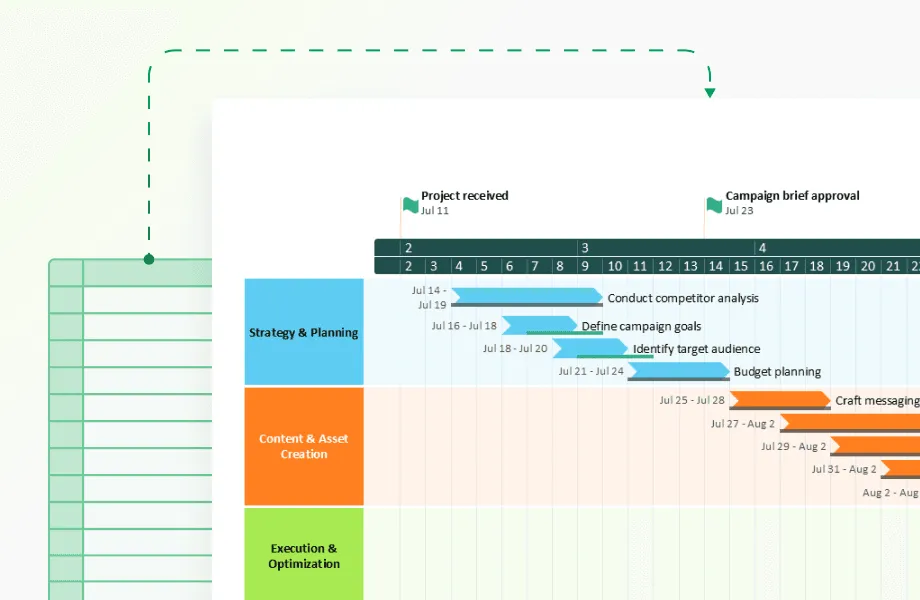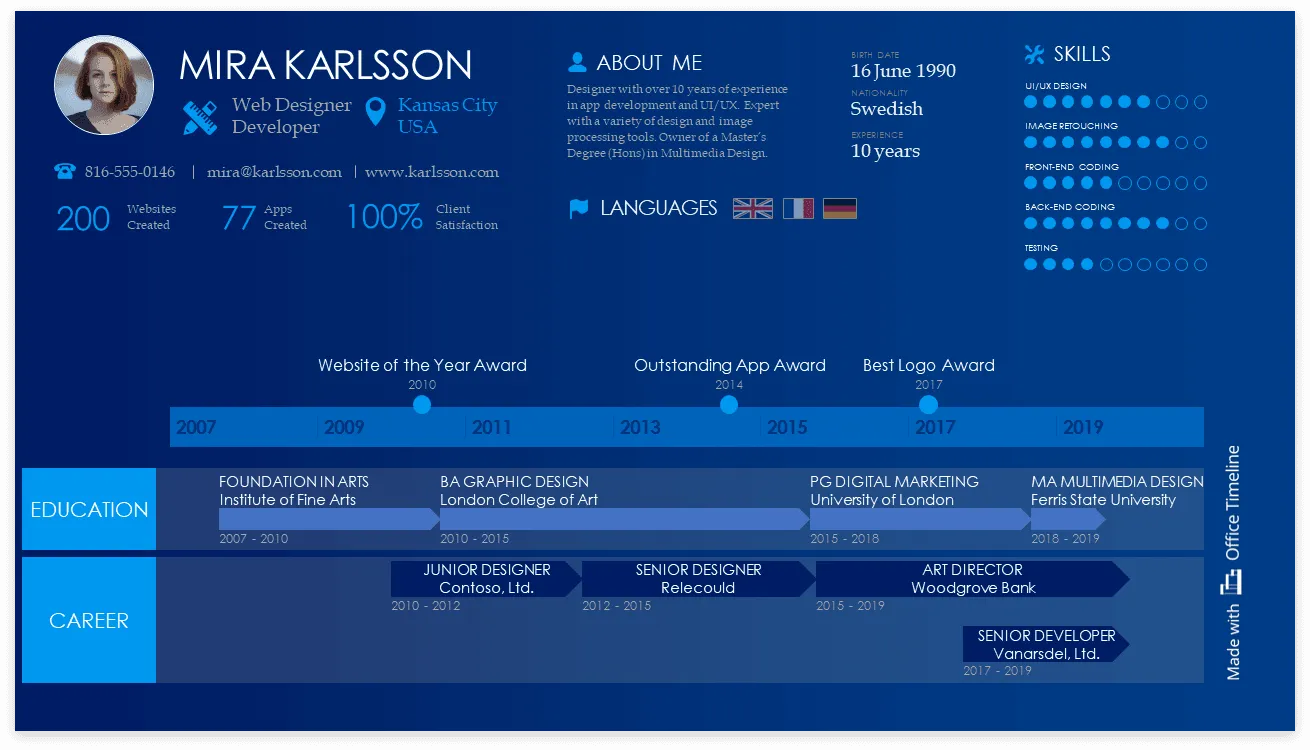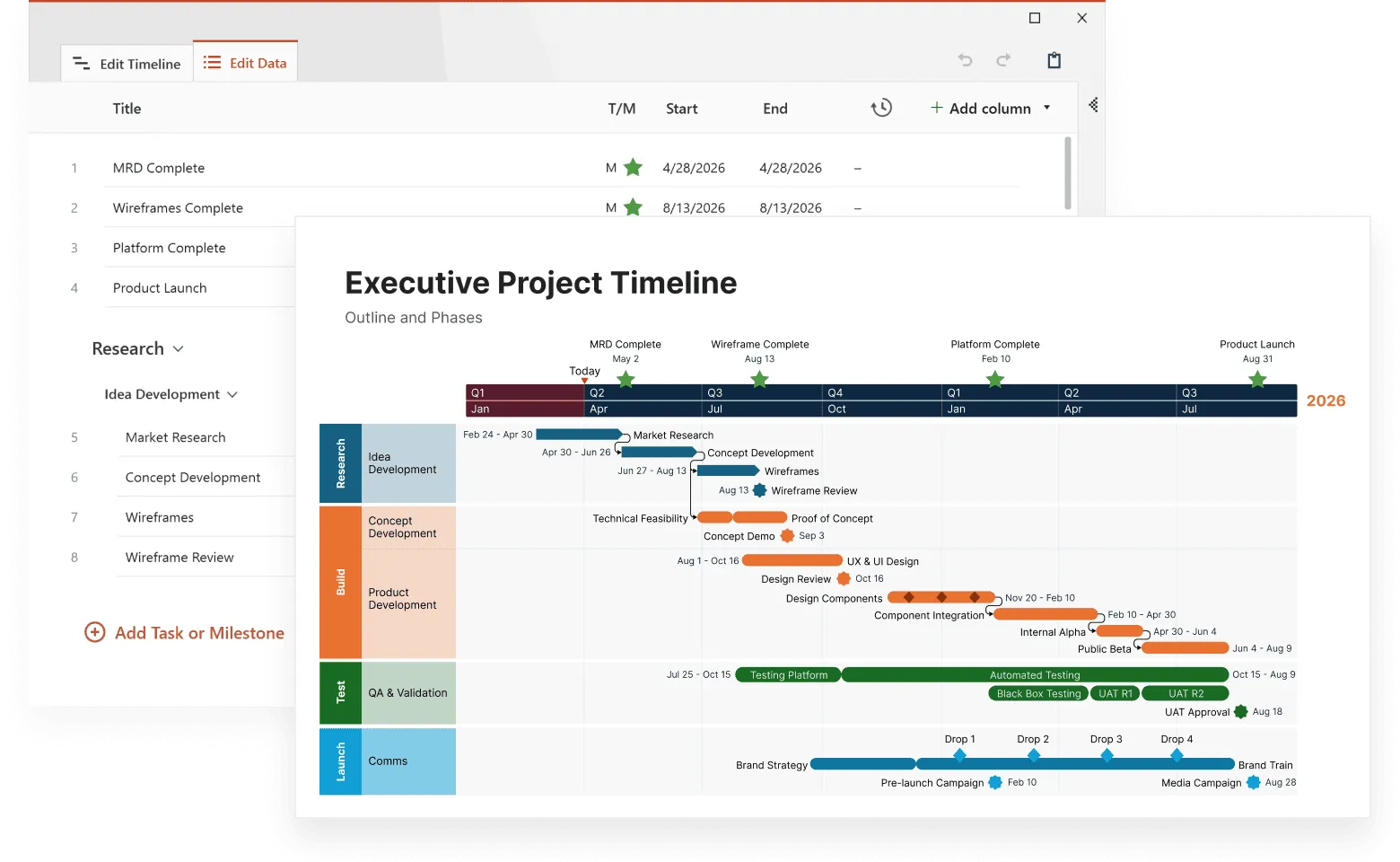Your achievements tell a story. A life milestones timeline captures your accomplishments, breakthroughs, and meaningful moments in one place, helping you see how far you've actually come.
When you document your milestones, you're acknowledging the effort, courage, and growth behind each achievement. This practice transforms scattered memories into a complete picture that shows your resilience and progress over time.
Whether you're tracking career wins, personal breakthroughs, or life-changing decisions, a milestones timeline gives you perspective. This guide shows you how to build one that reflects your unique path and inspires what comes next, and is part of our comprehensive timeline resources.
How to build your milestones timeline?
Life moves fast. Without intentionally recording your achievements, many significant moments fade from memory, taking away the lessons and confidence they gave you.
A milestones timeline changes this. Think of it as your personal collection of wins, the moments when you overcame obstacles, took risks, or reached goals you once thought impossible. When you're facing new challenges, looking back at what you've already done reminds you what you're capable of.
Beyond personal reflection, your timeline gives you tangible proof of your path. People use these for job applications, scholarship essays, personal development planning, or sharing their story with family.
Most importantly, a timeline helps you spot patterns in your success, what motivates you, when you thrive, and how you've grown despite setbacks.
Steps to build your milestones timeline
Building a meaningful timeline takes more than listing dates. You need to identify which moments truly shaped you and understand why they matter.
Step 1: Define your achievement categories
Start by deciding which types of milestones you want to capture. Focusing on specific categories makes your timeline purposeful and prevents it from becoming overwhelming.
Consider organizing by:
- Career achievements: promotions, major projects completed, skills mastered, leadership roles
- Educational milestones: degrees earned, certifications, courses finished, research published
- Personal breakthroughs: overcoming fears, building new habits, health transformations
- Creative accomplishments: projects launched, performances delivered, work published
- Relationship milestones: meaningful connections formed, family moments, community contributions
- Financial goals: first home purchased, debt eliminated, investment milestones reached
You don't need to track everything. Choose two or three categories that matter most to where you are now. You can always expand later.
Step 2: Identify your true milestones
Not every event qualifies as a milestone. Real milestones are moments that required significant effort, marked a turning point, or changed how you see yourself.
Ask yourself these questions about each potential milestone:
- Did this require me to push beyond my comfort zone?
- Did this moment change my direction or open new opportunities?
- Am I proud of what this achievement represents?
- Did I learn something valuable that I still use today?
- Would my past self be amazed that I accomplished this?
Be selective. A timeline with 200 items becomes noise. Aim for the moments that genuinely matter, usually 10-30 milestones per decade, depending on your life stage.
Step 3: Gather the details
For each milestone you select, collect the information that brings it to life:
Essential details:
- Exact or approximate date
- Brief description of the achievement
- Context: What made this challenging or meaningful?
Optional elements that add depth:
- Photos or screenshots from that time
- Who supported or inspired you
- Obstacles you overcame
- How this milestone influenced what came next
- A quote or thought from that period
Check old calendars, emails, photos, journals, or social media posts to verify dates and refresh your memory. These details matter, they transform a simple list into a rich personal history.
Step 4: Choose your timeline format
The right format depends on how you plan to use and update your timeline.
Digital timelines work well if you want:
- Easy updating as you achieve new milestones
- The ability to share your timeline digitally
- Interactive features like clickable events or embedded media
- Professional presentation for career purposes
Physical timelines work better when you want:
- A tangible reminder you can display
- Creative expression through handwriting and art
- Something to reflect on without screens
- A meaningful gift or keepsake for family
Many people maintain both: a detailed digital version for reference and a curated physical version highlighting only the biggest achievements.
Step 5: Add visual meaning
Colors, icons, and layout choices can make your milestones more memorable and easier to scan quickly.
Smart visual techniques:
- Color-code by category (career in blue, personal in green, etc.)
- Use icons or symbols to mark different achievement types
- Vary the size or style of entries based on impact level
- Add photos for major milestones to trigger memories
- Create visual breaks between life chapters or decades
The goal is clarity, not clutter. Each visual element should make your timeline easier to understand.
Make any life timeline simple to create
Try Office Timeline for free. From career paths to daily routines, build crisp timeline slides without the formatting hassle.

Examples of personal timelines
Creating a personal timeline is all about telling your story visually. The examples below will show you different ways to map out your life experiences, whether you're focusing on career milestones, family connections, or daily habits.
What makes these examples helpful is seeing how different aspects of your life can be organized and presented. From big life-changing moments to your everyday routine, these timelines can help you spot patterns and connections you might otherwise miss. Think of them as different lenses for looking at your life's story.
As you browse these examples, remember to adapt them to fit your own experiences. The best personal timelines reflect what matters most to you and help you see your life from a fresh perspective. Let's explore some specific timeline types you might want to create.
Significant life events timeline
A timeline of significant life events focuses on the moments that changed your direction in life. This might include getting married, having children, moving to a new city, or experiencing personal breakthroughs.
For example, you could create an event planning timeline similar to this one created with Office Timeline add-in for PowerPoint, which organizes important dates and milestones for special occasions. This format works perfectly for mapping out major life events - you can clearly see when each important moment happened and how they connect to each other. The visual layout helps you appreciate how these key events have shaped your life's path.
Career development timeline
Creating a career timeline gives you a clear picture of your professional growth. This type of timeline highlights job changes, promotions, major projects, and skills you've gained along the way.
This timeline resume example, created with the Office Timeline add-in, shows how you can visually represent your work history, making it easy to see your career progression at a glance. You can include positions held, companies worked for, major accomplishments, and professional certifications. This approach helps you recognize patterns in your career development and identify the experiences that have been most valuable to your growth.
Daily routine timeline
Sometimes it's the small, everyday moments that define us. A daily routine timeline captures how you spend your time on a typical day, revealing what activities you prioritize.
Using a format like the daily schedule template from Office Timeline, you can map out your regular activities from morning to night. This kind of timeline might show when you wake up, exercise, work, spend time with family, pursue hobbies, and wind down for bed. Looking at your daily patterns can help you understand your habits and see if your time use matches your priorities and values.
Making your timeline work for you
A milestones timeline offers more than nostalgia - use it strategically to improve your life moving forward. Here's what to keep in mind:
Spot your success patterns
Review your timeline every six months looking for patterns. When do you accomplish the most? What conditions help you thrive? Which types of challenges bring out your best work? These insights help you engineer future success by recreating the conditions that work for you.
Build confidence before big challenges
Before a major presentation, difficult conversation, or ambitious goal, spend five minutes reviewing your milestone timeline. Remind yourself: "I've done hard things before. I can do this too." Your past achievements become fuel for future courage.
Identify gaps worth filling
Your timeline might reveal areas you've neglected. If all your milestones are career-focused but you value relationships, that gap signals where to invest energy. If you've achieved much for others but little for yourself, that imbalance deserves attention.
Share your story more powerfully
When someone asks "Tell me about yourself" in an interview or networking setting, your timeline gives you a clear narrative to draw from. You can confidently highlight relevant achievements and explain how they connect to where you're headed.
Celebrate more intentionally
Add new milestones immediately after achieving them, while the emotions are fresh. Take time to acknowledge what this win means, who helped you, and what you learned. This practice trains you to recognize and celebrate progress, not just chase the next goal.
Conclusion: your life, your timeline
Creating a timeline of your life helps you better understand yourself by mapping out important events and their impact. It lets you appreciate your personal story and see connections between different parts of your life. When you spot recurring patterns, you gain insight into how you've grown over time.
Looking at both your successes and difficult times gives you a complete picture of what has shaped you. So why not give it a try and start recording your story? Making a personal timeline can be a real eye-opener, as well as a meaningful way to honor the path that belongs only to you.
Frequently asked questions
Here are answers to some common questions that might help you get started with your personal timeline project. From basic definitions to practical tips, these questions cover what most people want to know when creating their first personal timeline.
Include achievements that required significant effort, marked turning points, or changed your direction. This covers external accomplishments like graduating, career promotions, launching projects, or buying a home, plus internal growth like overcoming fears, building new habits, or developing skills. Focus on moments that still matter to you when you think back on them.
Aim for 10-30 milestones per decade, depending on your life stage and how selective you are. Too few and you miss important context; too many and your timeline becomes cluttered. Quality matters more than quantity. Choose the moments that genuinely shaped your path rather than trying to document everything.
The best format depends on how you'll use it. Digital tools like Canva or Notion work well for easy updates and sharing. Paper timelines are better for display or creative expression. Many people keep both: a detailed digital version they update regularly and a curated physical version showing only major achievements.
Most people organize chronologically to see their progression over time. However, you can also create separate timelines by category (career, education, personal growth) if you want to focus on specific life areas. Both approaches work—choose based on what helps you see patterns and progress most clearly.
Yes, include setbacks that led to growth or became turning points. A job rejection that redirected you toward something better, a failed project that taught valuable lessons, or a difficult period that built resilience all belong on your timeline. These moments add authenticity and show your complete journey.
Start with basics: approximate date, brief description, and why it mattered. For your most important milestones, add context about the challenge, who helped, and what you learned. You don't need to write paragraphs—a few sentences captures most milestones effectively.
Approximate dates like "Summer 2019" or "Early 2021" work perfectly fine. Focus on getting events in the right order and capturing their significance. You can refine dates later if you find old photos, emails, or documents. Perfect accuracy matters less than the overall story.





